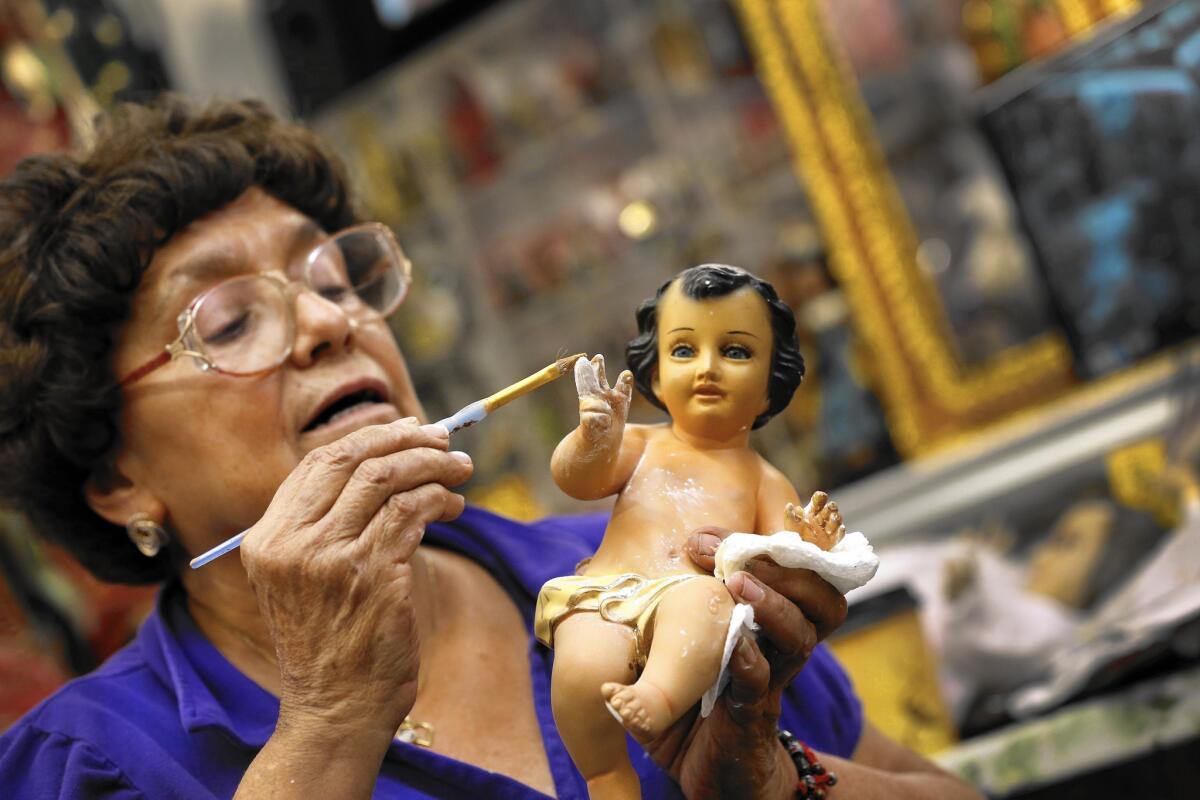Resurrecting baby Jesus takes a little paint and a fancy dress

- Share via
Isidora Ramos walks in just before sundown with a baby Jesus missing two fingers.
Her poodle, Gary, sneaked into the manger one night after Christmas, knocked over the cows and the sheep, and pounced on the newborn.
“Por favor,” she tells Christina Parodi. “Is there any way you can fix him before Sunday?”
“Leave him here,” Parodi says. “I’ll see what I can do.”
It’s the time of year when Parodi is swamped with baby Jesuses. They crowd the work table in her shop at Boyle Heights’ El Mercadito. They line her countertops, and her storage bins brim with broken pieces: missing arms, shoulders, legs and toes.
Their owners bring them from Bell Gardens, West Hollywood, the Valley; from as far away as Fontana, even Sacramento, hoping Parodi, a short, round woman with a perfectly groomed wig and an array of paintbrushes, acrylic paint and plaster, can resurrect them.
If she succeeds, she will have done so by Sunday, the day before Dia de la Candelaria or Candlemas, when the infant Christ must look his best for his first visit to church.
So, on a recent afternoon, Parodi eases into her work chair and reaches for a complicated case: a life-size baby Jesus dropped off with a guillotined head.
It had been shipped to the owner from Mexico.
“Poor guy,” she says. “I think Customs wanted to make sure he wasn’t a narco Jesus.”
From her chair, the 69-year-old Downey resident does her best to draw in believers. With just days remaining until the big moment, they stream into the swap meet by the dozens, cradling nude Jesuses.
“Come in! Come in!” she yells. “What do you need? We have it all. If you buy your Jesus gown here, we’ll clean him up with holy water, make him shine with baby oil and I’ll retouch him for free!”
She spends hours each day on the dolls, charging $5 to $10 per limb. But the repairs are mostly a bonus to draw customers. Her real profit comes from the gowns people buy for their Christ once he’s back in one piece.
The 2015 baby Jesus catalog features a dozen glossy pages of options, each designed by Lucia Amelia, a renowned baby Jesus clothing designer from Mexico City. Her collection features gowns with billowy sleeves made of silk and lace, sequin and tule, each with coordinating accessories: crowns, rosaries, wings and, often, pleather huaraches.
If you’re in need of money, you might dress your infant in the aqua blue “Prosperity Baby Jesus” outfit. If you’re feeling ill, you could try the red and gold “Health” gown. If there’s drama in your life, your best bet is probably the “Peace” frock, which comes in white and blue, with a miniature dove.
There’s also a selection of saint outfits, including the personal favorite among many Mexicans, Saint Juan Diego.
Prices range from $14 to outfit a jalapeño-sized Jesus to $45 for a life-size doll.
Some customers want their Christ to dress like a mariachi, a day laborer, a rancher or Kobe Bryant.
Parodi gently scolds them, then offers holier options.
She’s got plenty of competition at the market. Nearly a dozen shops sell the same dolls and the same gowns. Once in a while she groans about the shop across the way because she says they steal her customers.
“They say they’ll wash your Jesus in holy water,” she says. “But it’s just water from the tap.”
She’s not really worried, though.
Her shop has been around for 40 years. And she’s the only one who repairs Jesuses on site.
She began selling the plaster babies and their outfits about 25 years ago due to customer demand. The Catholic holiday is a festive time in Mexico. Fireworks blast from the plazas and the faithful lift their baby Jesus from the manger he’s been lying in since Christmas and dress him in his finest wear.
They take him to church and showcase him on the altar, along with dozens of other newborn Christs, for all parishioners to see.
“It’s something very special,” says Ramos, the poodle owner. “My mother did it, I do it and one day my daughter will do it too.”
The tradition comes with a set of guidelines, the most important being: Every year Jesus must don a new outfit. And if the gown doesn’t fit on the first try, you mustn’t force it.
“It means Jesus would rather wear something else,” Parodi said.
Some pass along the dressing responsibility to a “godmother,” who must dress the child for three years in a row and throw a party in his honor.
When the doll is returned to the owner’s home, he is placed on a throne for year-round display and prayer — until the following Christmas.
Customers who come to see Parodi often like to take a seat and chat about their doll. Some have had their Jesus in the family for generations. Others were given the child for their wedding or in a time of need. A few come in with “smuggler” Jesuses, dolls they held tight in their arms as they crossed the border.
Teresa Perez, 47, settles onto a stool looking to dress seven Jesuses. None of them are hers.
“I’m their foster mom,” she says, laughing.
Two belong to her sister, two to her daughter and one to her neighbor. Years ago they placed them on her nativity scene and never returned for them. This week, a neighbor died and she inherited two more.
The Koreatown resident can’t work due to health issues so she relies on her husband and daughters for money to dress her collection, often in identical outfits. This year it cost her $180.
“They deserve it,” Perez says. “They do so much to protect me all year long, it’s the least I can do.”
With little time left, Parodi works 11-hour days to fulfill her orders.
As closing time approaches, two godmothers from East L.A. walk in with six Jesuses, each in a silk-lined Moses basket. The dolls have dollar bills tied to their hands and are covered in confetti and jelly beans left over from Christmas.
“Wow,” Parodi says. “These ones partied hard.”
She’s seen so many Christs over the years. Still, some customers manage to surprise her with their devotion.
Tonight, it’s Alvaro Morales.
The factory worker from Bell Gardens says that one year he grew tired of the tradition he had honored since he was 6 years old.
He took a good look at his Jesus and told him: “This time I’m not going to dress you. I’m going to gamble instead.”
At the casino, Morales says, he lost all his money, plus a gold ring.
Morales says he learned a valuable lesson that year, one everyone should keep in mind.
“Don’t mess with Jesus.”
[email protected]
Twitter: @LATBermudez
More to Read
Sign up for Essential California
The most important California stories and recommendations in your inbox every morning.
You may occasionally receive promotional content from the Los Angeles Times.











